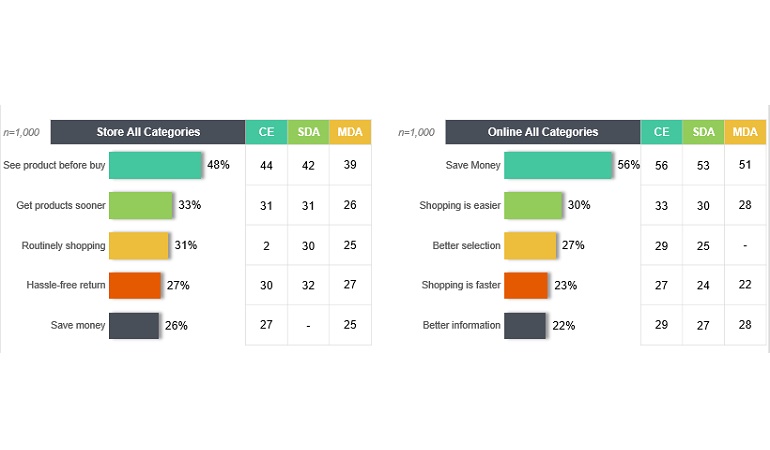Latest shopping behavior data revealed.
Written by GfK Australia account executive, Sarah Laird
According to GfK’s FutureBuy study, in Australia 24% of shoppers claimed to have purchased small appliances and major appliances online in the last 6 months, with only 15% of shoppers claimed to have purchased packaged food and beverages online in the past 6 months. So it appears that a growing number of shoppers are turning to online for larger ticketed items, while grocery shopping largely remains loyal to bricks and mortar.
So why is it, in our increasingly connected lifestyles, with our phones or our tablets never far out of reach, that we still make a large proportion of our purchases in physical stores?
The top reasons for shopping in a physical store versus online differ, as the below demonstrates:

Fig 1: Top 5 reasons for buying in physical stores versus online for Consumer Electronics (CE), Small Domestic Appliances (SDA), and Major Domestic Appliances (MDA).
Shoppers still rely on the physical store as a means for seeing and feeling the product before they buy. In the case of shopping for appliances, it’s partly to visualise the appearance of the product in-situ and how it will fit in the home environment, and get a real idea of how a product feels.
33% of shoppers considered getting the products sooner as a key reason for shopping in-store, and 31% thought that routinely shopping in physical stores was the reason they chose to purchase here. 42% of shoppers considered in-store displays to be an extremely/very important factor in their shopping decisions.
When looking at reasons why people chose to shop online, the most important factor was saving money, at 56%. Consumers also considered shopping to be easier (30%), and a better selection offered online at 27%. Online is an easily accessible platform to most – with some people browsing on the train on the way to work, and some shopping on the work laptop on their lunch break.
31% of shoppers like when a website keeps track of their visits and then recommends things to them, suggesting that more purchases could potentially be made off the back of the original trip. When considering what would get them to make more online purchases in the next year, 33% thought that personalised offers based on shopper behaviour would appeal to them.
When asked to think about reasons why they would not buy online, 35% of shoppers agreed that it was difficult to return items, and 43% said they would prefer to see the product in-person. But out in front, more than half (51%) said that cost of delivery was a hindrance, as the below graph demonstrates.

Fig 2: Barriers to buying online more often.
It follows then that when asked what would encourage them to purchase more online in the next year, a whopping 71% agreed that free delivery would entice them, and 43% agreed same-day delivery would encourage them to purchase more online. An increasing number of online stores are now offering free – or free over a certain spend – delivery, and some are now offering same-day delivery (albeit for a premium price).
ABOUT SARAH LAIRD & GfK
Sarah Laird is an Account Executive in the major appliances team at retail research and datahouse GfK Australia. A self-confessed ‘reformed shopaholic’, she focuses on point of sale tracking data.
For further information on FutureBuy reports, contact Norrelle Goldring: norrelle.goldring@gfk.com

